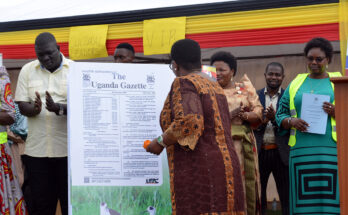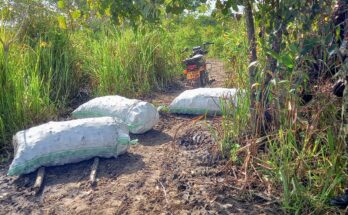In 2021, French energy giant TotalEnergies began constructing a 700-acre industrial area in Buliisa district as part of the controversial East Africa Crude Oil Pipeline (EACOP) project that will host construction camps, a drilling support base, and a Central Processing Facility with a capacity to process 190,000 barrels of crude oil per day.
The initial part of this construction involved clearing huge swathes of trees to pave way for the vast site. Since that time, however, floods have been rampant in communities – such as Kasenyi and Ngwedo – in Buliisa district, ripping through farmlands, water sources and have also become ‘drinking points” for the marauding elephants sneaking out of the neighbouring Murchison Falls National Park were EACOP activities are taking place.
Buliisa District Environmental Officer, Rogers Tusiime, accuses TotalEnergies of clearing the vast site “without having a proper plan in place” adding that this has exacerbated the impact of flooding which have since affected more than 4,000 people.
“They cleared everything without a proper drainage channel,” he said. “Total needed to cut these trees in phases because they help control the speed of running water whenever it rains,” adding that the EACOP has massively changed the landscape in the areas thus fueling more elephant attacks.

A new study released at the COP28 on Sunday shows that at least 918 protected areas have ongoing or planned fossil fuel extraction projects within their boundaries globally, with a total of 2,337 active or proposed oil, gas, and coal extraction projects within legally protected areas.
At least 50.8 Giga tonnes of potential CO2 emissions from oil, gas, and coal reserves, the study adds, are on track to be extracted from projects within protected areas over their lifetimes, according to industry projections, which is “more than three times the annual emissions from the US and China combined”.
Tyson Miller, Executive Director of Earth Insight said at the COP28 that “failing to safeguard protected areas from fossil fuels is symptomatic of a system gone awry, but also represents a huge opportunity for countries around the world to make commitments that address the biodiversity and climate crises we face.”
Kjell Kühne, Director of the Leave it in the Ground Initiative (LINGO) added that oil activities like the EACOP “would be tragic if we devastated more of our incredible natural heritage for additional bits of dirty energy in the very last years of the fossil age. As the world is getting ready to end fossil fuel extraction, our message on projects in protected areas is simple: start here.”
Meanwhile in Uganda, National Environment Management Authority’s Spokesperson, Tony Achidria says an environment assessment conducted on the EACOP was objective and “spot on” adding that the floods are caused by climate change just like other parts of the world.
“The biodiversity in the national park is safe,” he said. “This is because TotalEnegies is using the latest eco-friendly technologies that have been recommended by a team of experts to extract oil without damaging the environment.”
Uganda Wildlife Authority Spokesperson, Bashir Hangi denies that the oil activities are playing a part in the elephant attacks saying the lumbering giants“ move to many neighbouring places for many reasons like food”.

Despite that, more than 500 locals in the Albertine region have since petitioned the Uganda Wildlife Authority over elephant attacks caused by “oil-related activities” taking place in the Murchison Falls National Park, which has the highest number of elephants totalling 15,000.
TotalEnergies, who own the majority stake of 62 percent in the EACOP project, however, denies these accusations arguing that Buliisa is “historically prone to flooding”, especially during rainy seasons.
At the moment, the oil giant says it has contracted a firm to conduct a hydrological study to develop a retention pond system that can curb the devastating floods.
“Some of the activities that were conducted during the study included: a review of existing topographical data for the site, condition assessment of the existing temporary site drainage system, review of historical rainfall intensity, duration and frequency data for flood forecasting and modelling drainage in the project site. This was a prerequisite to designing the proposed solution – a retention pond system,” said TotalEnegies’ Spokesperson Stephanie Platat.
“Currently, two retention ponds are being constructed at the Central Processing Facility to hold 102,516.5 cubic meters and 279,384 cubic meters of water respectively, with a plan to later release the water through the existing drainage channels at a controlled pace to avoid damaging neighbouring land”.
Platat also noted that TotalEnergies intends to implement livelihood programs in two phases – “the first to ensure food security after relocation, moving onto delivery of additional programs to improve and diversify livelihoods”.
The situation has forced many environmentalists to drag TotalEnergies to court but none has yielded fruit. Recently the East African Court of Justice (EACJ) threw out a legal challenge by civil society actors that sought a temporary injunction to stop the construction of the EACOP until environmental, social justice, and climate justice concerns were investigated.
Dickens Kamugisha, the Chief Executive Officer of the African Institute for Energy Governance (AFIEGO) and one of the applicants said “despite the setback we have suffered, we remain determined and are prepared to appeal this unjust ruling, firmly believing that the dangers posed by EACOP can and will be stopped.”
This story was produced with assistance from MESHA and IDRC Eastern and Southern Africa Office for science journalists reporting on COP28.




